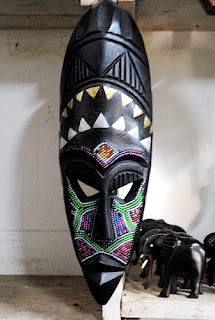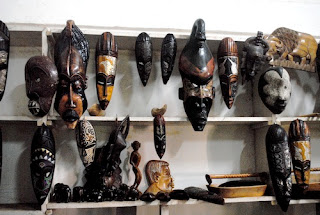There’s a raging thunderstorm going on around me, the power just went out, I think my ceiling is leaking, and thunder and lightning are reverberating through and illuminating my bedroom. Needless to say, I can’t sleep, so I’m going to take advantage of my current insomnia to blog about my trip to Kpalimé’s Centre Artisanal! Monday was my first day with absolutely nothing to do. Chantal was taking the day off for some much needed rest and relaxation, Emily left, and Ashley hadn’t come back from the states yet. I was bored. After doing some morning honors thesis research and finishing the quality control curriculum, which I will blog about later, I got really really bored. The town and tourists alike boast about the artisan center, and it’s something that I had always wanted to see because it contributes to Kpalimé’s identity and reflects its rich artistic tradition. So I caved and let Abalo, my neighbor who thinks he’s my boyfriend, take me there because I needed to go with a local so I wouldn’t get scammed and so I could communicate with those who didn’t speak French.
I was a little apprehensive about going because of what happened to Chantal’s father, and because I know it makes business difficult for unaffiliated local artisans due to its monopoly on tourists. The center has the greatest variety of pottery, batik and woodwork to be found in one place, and tourists have no reference for how much the center marks up the price, nor do they have adequate information about alternative artisan workshops. Chantal has mixed emotions about the center as well that she had previously conveyed to me, saying that while she appreciates the fact that the center promotes artisan development and teaches skills, albeit at a high cost, it also takes away business from those who don’t want to get involved because it takes away many of their profits by charging high fees just to exhibit their work, or to those who can't afford to pay for the apprenticeships.
The artisan center consists of workshops, classrooms, display rooms/stores, courtyards, and lodging facilities for those who come to learn from surrounding villages. We first passed by the pottery studio, and there was a lone woman sitting outside with purple hair polishing off a bowl with a flat stone. She was excited by my presence, and she showed me the entire stock room of pottery, as well as the firing kilns, the glaze and then the store with all of her products for sale. Pottery is challenging to sell because its fragility means high costs and efforts for transportation, often outweighing the benefit of purchasing it in the first place. While many of her things were beautiful, it just wasn’t practical for me to buy anything since first of all I had no need for it and it second it wasn’t worth trying to figure out how I would fit it into my already stuffed suitcase, due to my overpacking and a shopping problems, a lethal travel combination.
We moved on to the woodshop, where I was initially entirely overwhelmed because the room was jampacked with literally everything imaginable that could be produced from wood; jewelry, masks, animals, drums, toys, household items—and then some. To make matters worse, Abalo decided to be really annoying by pointing out EVERY single product and telling me what it was, as if I couldn’t figure it out for myself. When I stopped responding to him he found these numb-chuck like noisemakers and proceeded to whack them about while still following me around the entire store, until I snapped and told him to stop and shut up. I felt bad for being mean and hurting his feelings so I took a mask off the wall and goofed around to cheer him up. It’s like I was hanging out with 2-year-old Gad rather than 21-year-old Abalo. It was then that I noticed how amazing all of the handcrafted wooden masks were. They were so intricate, so embellished and detailed, that for all of my friends who know my magpie ways and know how I can’t resist anything that sparkles and shines, this shouldn’t come as any surprise: I bought a gold and silver one. Only after having a very taxing internal debate because I couldn’t decide between the one I bought and a black one with colorful beaded details.
Because I was so impressed with all of the woodwork and because I got to tour the area where all of the artisans were working on their woodwork, seeing the batik shop after was such a letdown. To be fair, I’m spoiled because of my experience and exposure to Chantal’s work and quality, but even so the batik at the artisan center was so average and uninteresting, I felt almost ashamed that that’s what is representing Togolese batik to western tourists. I was guessing that asking them to pass out Aklala’s business card, for the sake of the craft, wasn’t really going to fly.
But that’s a major component of business and retail, determining who your biggest competition is and how to tap into their market share. While passing out business cards to the center’s customers would get me in a lot of trouble with the management, there are other, safer, ways to attract more local business and markets for Aklala. It’s going to be a big challenge to help them achieve a large enough community presence to the point where they can draw in tourists on their own behalf, rather than through existing volunteer connections. But we are determined to find as many outlets we can, advertise and market to local hotels, western NGOS and other artisans who wanted to support each other’s crafts. The craft industry is currently very fragmented; in part because of its diversity, but improving industry coordination may be a key lever to strategically address the other challenges facing the sector, namely helping all artisans gain access to western markets as well as build up local consumption capacity, but as per usual I’ll get into that later :)












No comments:
Post a Comment